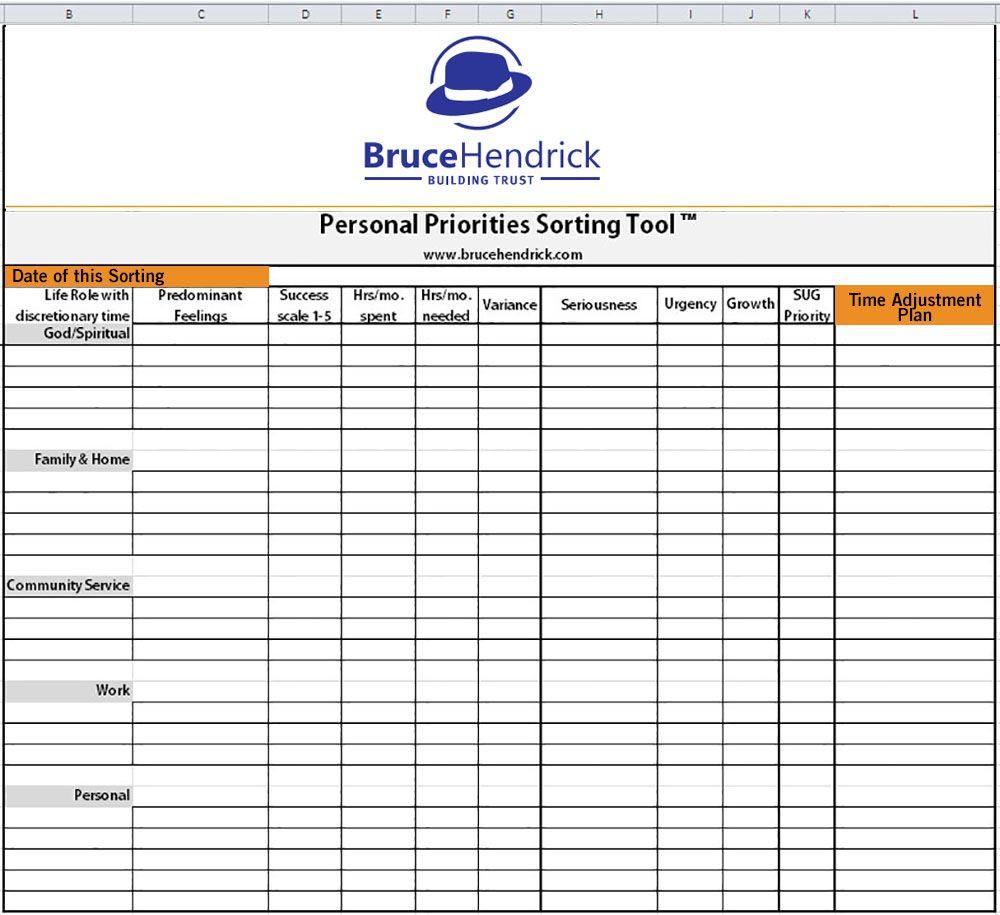Overcoming Superman (or Wonder Woman), Part 2 of 2
In Part 1 we discussed the common struggle for so many of us: saying ‘no’. Superman Syndrome (I did not make this up) is a catchy name for it; our last question came from someone who wanted to leave their cape behind.
When we know in advance what we’d prefer to say ‘yes’ to, saying ‘no’ is much easier. We can frame it from within the context of our ‘yes’.
For example: “Thank you for inviting me into this new ministry but I’m already devoting all the time I can right now to x and y at the church. If something opens up, I’ll be sure to reconsider your invitation.”
Sounds easy. And it can be, but only when we are confident that our most important priorities are governing our time commitments. The ODS tool described below is designed to do just that.
Building Trust Personal Priorities Sorting Tool™
This tool helps people create appropriately balanced lives – according to their own definition – and the process is not for the weak of heart. I advise my participants to sit quietly alone to work with this tool. A rainy Saturday is a good choice. For best results, fill out the sheet honestly and quickly. If you feel like a victim who can’t make any adjustments in how you spend your time, wait until you are stronger before you try it!
Instructions
Step 1: On the left side, list the significant roles that will command your time over the next 6-12 months. Include main responsibilities plus other activities that can take up substantial amounts of your discretionary time. When in doubt, include it.
Step 2: List one or two predominant feelings you have about how you are doing in each role. Don’t overthink it. Are you feeling overwhelmed? Excited? Happy? Exhausted? By the end of this step you may glimpse how saying ‘no’ may get easier!
Step 3: On a scale from 1-5 with 5 being highest, rate your sense of how successful or effective you are being today in each role. Be fair with yourself; they can’t be all 1’s or 5’s.
Step 5: List the time you think you might need to spend, on average, to be as successful as you would like in each role. Again, don’t expect 5’s from yourself on every role. Your answer could be more than, less than, or the same as you are currently spending.
Step 6: Subtract the times to get the Variance. Don’t worry if things seem bleak – they will recover soon!
Step 7: Now comes the toughest part, the prioritization step. The roles you play do not all carry equal priority. If you can simply force-rank from highest (= 1) to lowest priority, go for it – and put your ranking in the SUG Priority column.
For those like me who need prioritizing criteria, these work extremely well: for each role, decide:
Seriousness: Fill in High, Med, or Low. High seriousness means it matters greatly to your results for what you consider an appropriately balanced life. Low = not so much.
Urgency: Highly urgent means you need to deal with this role/issue right away. Low means it can wait until you get around to it. Med is somewhere in the middle.
Growth: High growth means the issue/role will grow significantly over time. Low growth means it will not grow at all. Again, Med is in the middle.
Determine the SUG Priority column by finding the most High’s from left to right, then Med’s, etc. (the 2nd tab in the ODS tool (link again) does this for you).
Step 8: Decide , based on your new priorities and time variances, what adjustments to your time commitments are needed. Some roles may require dramatic changes, while others none at all. Some roles, while time-consuming today, may not make your top priorities, in which case you’ve just found a good reason to start saying ‘no’ with confidence.
BTPPS Tool At Work
This tool is powerful in the workplace , for stress relief and improved communication. The worker takes Steps 1-6 on their own, and then meets with the boss for Step 7 to jointly prioritize the job roles. This can be especially revealing, as differing views on seriousness and urgency often emerge. Step 8 can also be done together, thereby ensuring a plan with which both people can be comfortable.
BTPPS Tool In Life
As with any tool, this one has its limits too. Priorities change and develop. New non-negotiable tasks and duties drop in our lap. How we spend our time is much like an investment portfolio – it needs to be re-adjusted periodically or it gets out of balance. Those of us who have trouble saying ‘no’ must often be the most diligent investors of all.
How do you personally prioritize? Have you used the Building Trust Personal Priorities Tool ™ ? Feel free to question, comment or share your experiences below!
Images Source: Building Trust, LLC, Google Images





